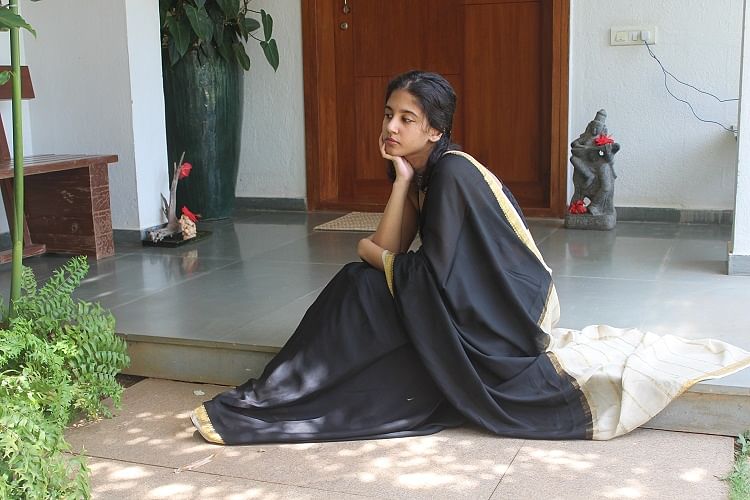
There is hardly an attire as versatile as a sari. It may have had humble beginnings but today it is every fashionista’s go-to outfit. Here is how the millennial women of Bengaluru are styling this timeless fashion piece, in boardrooms, at dinner dates, and while catching up with friends.
The number one factor today’s women look for in their attire is comfort, says Shloka Sudhakar, fashion designer. “Women today look for comfort in anything they buy or wear. To be comfortable, they’re opting for lightweight saris or fabrics that are easy to handle,” she says.
Apart from comfort, modern women are keen to add their own twist to the traditional attire, designers in the city have noticed.
“They don’t want it to be in a regular sari look. I have seen young girls wearing saris with denim pants and skirts or even using fancy crop tops as cholis. They have found their unique ways of draping a sari,” says Namrata G, fashion designer.
Take the case of Sangeetha Alwar, who started wearing saris to work when she was teaching. Today she has found her own way of incorporating saris in daily life. “I’m leaning towards pairing saris with crop tops. They look amazing and add a casual look to the outfit,” she says.
Tanya Sharma fell in love with the sari after she stumbled upon her mother’s treasure trove — a collection of saris of over 30 years. She feels even the simplest tricks can lend a modern edge to saris.
“Wearing sneakers with a sari is hands down one of my favourite ways to style it. It’s comfortable, easy to wear, and gives an edge to your outfit. I reject the notion that saris must only be worn with heels or jutis. The whole point of reintroducing saris to a new generation is to let them cultivate their own styles,” she adds. Now many homegrown brands have started making saris with contemporary aesthetics.
‘Saris make me feel beautiful’
Entrepreneur and social media influencer, Sushmitha Gowda, feels the most confident in a sari. “Sari makes me feel beautiful and confident like no other piece of clothing does. I feel comfortable in a sari because I get to drape and style it the way I want. It gives me freedom,” she says.
For Sangeetha, her journey of self-love and acceptance began in many ways with a sari. “Initially, saris were my way of overcoming my body image issues. They covered parts of my body that I did not like. When I started wearing them regularly, it helped me become more confident in my skin. I love how a simple piece of cloth can be so flattering,” she says.
Would you wear a sari on a date?
“I wear saris on most of my dates and they’ve worked brilliantly for me. They are also super versatile. I can wear them on a date or to an art gallery without bothering if they look out of place,” says Sangeetha.
A simple sari paired with right accessories makes for a perfect date-night outfit, believes Sushmitha. “For a date, I would pair a plain chiffon sari with a cotton blouse and accessorise well,” she says. Statement earrings, chokers and belts are some of the most common accessories worn with saris today.
Be it a dinner date or a night out dancing, saris can be worn everywhere, says Tanya. “If I was going to a club or pub, I’d probably pair the sari with a pair of combat boots or white sneakers and wrap the pallu around my neck for ease of movement,” she adds. She has been using social media to normalise traditional saris as everyday wear, appropriate for all occasions.
Current trends
“I think designers will never stop experimenting with saris and incorporating them into other forms and designs. There are sari gowns, draped sari dresses, corset saris and so much more,” Shloka says why sari will never go out of vogue.
While pre-draped saris were all the rage up until last year, the trend has been dying lately with more and more customers preferring traditional saris with a modern twist.
“I recently launched a line of corset saris where a blouse is worn, a sari is draped and then a corset is worn over so it keeps the sari intact at all times,” she says. Corset saris are inspired by the Regency era in the UK (1811-1820), which is currently one of the popular fashion trends, especially on social media.
Slow and sustainable fashion has also been getting popular among modern Indian women. “A lot of people are gravitating towards slow and sustainable fashion today. There has been a conscious shift recently and the focus is now on supporting local weavers,” says Namrata.
“On principle, my mother and I don’t buy saris unless we know the weavers are paid fair wages. We forego big brands for some of these smaller sellers. Over the past two years, I’ve also made it a point to buy directly from weavers in Benaras, Kadapa, Karaikudi and other small cities I’ve travelled to,” adds Tanya.